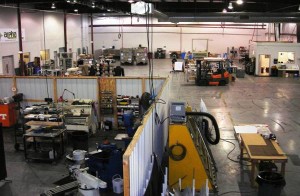While every machine shop is different, you’ll see similar set-ups when you walk through them. There will usually be the main area where all of the CNC milling or turning centers are, as well as a section to deburr parts. Sometimes there will be deburring tools/machines next to the machine you’re running if the operator does all of the deburring.
Usually in a different area there will be a stock room with all of the raw materials needed for upcoming jobs. These few rooms or areas make up a CNC Machine Shop, which is usually a large industrial or steel building, as well as a small pole barn or garage, depending on how big the company is.
Stock Room
Round stock, square stock, and tubing are the most common, and they are usually 8 or 12 foot bars in length. There should also be a band saw in this same room so that someone can cut up the right size stock for each job. Most shops have an automatic horizontal band-saws so that they can cut a large quantity of parts in a short period of time with relatively close tolerances.
Machines

Depending on what kind of a machine shop you’re in, there’s a lot of milling machines that could be running. While milling and turning centers are the most common, there’s many more machines, as well as different variations of each.
A shop can have vertical or horizontal milling centers, depending on how complex their parts on, and if they’re a job shop or a production shop. Vertical mills are the most common because they’re cheaper and easier to use and set up.
Lathes are pretty similar, but they can be a flat-bed, slant-bed, multi-axis, or have live tooling for special jobs.
Other machines include, but not limited to: Wire EDM, waterjet, press brake, turret punch, CNC laser, as well as miscellaneous deburring machines (tumbler, straightliner, grinders).
Deburring
Like mentioned above, there will be some deburring tools/machines if the company wants to save money by doing all or most of it themselves. Often times there will be a drill press and grinder next to each mill so the operator can do most of the deburring right there in between cycle times.
The higher quality and quantity the parts, the bigger and better the deburring equipment will be. Giant tumblers/vibratory tubs are often used in large production shops for basic deburring. Media blasting is also common for parts if they are to be plated or coating with something. Zinc, chromate, anodizing, hardcoat/powdercoat, and nickel are just a few coatings that are done to machined parts to give them a better look, last longer, and/or function different.
Inspection Room

The inspection room should be separate and enclosed from the shop. If parts have close tolerances, there will be expensive inspection equipment, and the room will be temperature controlled so all of the readings are accurate and consistent.
Tools will include: a granite surface plate, height gage, CMM, bore gage, go/no-go gages for specific jobs, optical comparator, profilometer, thread gages, and gage pins. Not every job will have all of these tools, but some will have more.
Depending on how big the shop is, you (the Machinist), may or may not be inspecting your own parts. The more machines and tools you learn how to use, the better off you will be, so try to get in on how to use the equipment if there is an inspector at your shop.
Well, that’s the jist of what a CNC Shop has on the inside of it! Check out my other articles for tips on becoming a CNC Machinist. Stay tuned for more…
